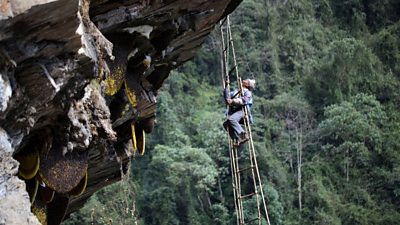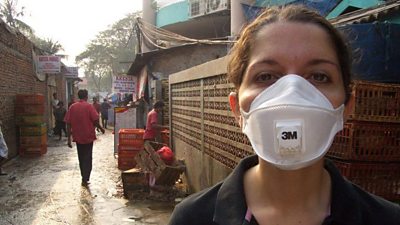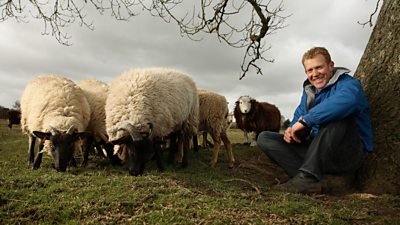It considers only the risks resulting from being stung, and does not consider other related risks, for example, due to access. Whilst specifically about bees, much of the information given here may equally apply to filming wasps and other stinging insects.
What Can Go Wrong?
- Getting stung (mild reaction) – immediate sharp pain, followed by localised swelling, itching and sensitivity. Unless in an airway, an eye, or it subsequently becomes infected, the effects should subside within a day or two without medical intervention. Anti-histamine treatments can give some relief.
- Getting stung (severe reaction) – in addition to the above, in some people the venom may trigger the body’s immune system to produce a rapid (i.e. within minutes) set of further symptoms in parts of the body away from the site of the sting; termed anaphylactic shock, or anaphylaxis, these symptoms can include rapid drop in blood pressure, difficulty with breathing due to airway swelling, fainting, itchy rash and possible abdominal pain. Although rare, the condition is life-threatening. Unless an individual knows they have an allergy to bee stings, it isn’t possible to predict how an individual will react to a single, or multiple stings, though severe reactions typically require at least one previous ‘sensitising’ sting.
Legal/�鶹�� Requirements
- There are no specific legal requirements to draw to your attention; you must still apply the control measures that are relevant to your activity.
Control Measures
Planning
- Engage an expert – this will typically be a bee-keeper, scientist, pest-control officer or similar. In the UK, the bee-keeper should ideally be a member of the British Bee Keeping Association (BBKA) – equivalent organisations exist overseas. Verify membership.
- Bee-keeper responsibilities - they will be responsible for planning and managing your interactions with the bees. They should advise you on when and what can be achieved safely, and how you need to prepare yourselves for filming (see more below). They may be able to give you a risk assessment or information sheet. They should bring with them any equipment needed to handle or approach the bees, including ‘smokers’.
- Check team for allergies – if you can, avoid taking team members with you who know they are allergic to bee stings; if in doubt, speak with �鶹�� Occupational Health.
- Personal protective equipment – depending on the risk of being stung, use a smock or full body suit with integral hood and elasticated cuffs/ankles, and some leather gloves (with sleeves / cuffs). The suit will typically be white or lightly coloured and should have zips and velcro flaps to prevent possible bee entry. Note: made of cotton, bee-suits trap but do not prevent a sting passing through them so you need to wear a layer of clothes underneath them to prevent it reaching your skin. The suits come in various sizes and need to fit the individual.
- First aid arrangements – you need to make sure that appropriate first aid can be given should anyone react to a sting. If your risk assessment indicates a need for adrenaline / epi-pen due to a past reaction (mild or severe) to bee, wasp or insect stings you should arrange for those individuals to have these prescribed by their GP. Note: adrenaline / epi-pen is a prescription only medication (POM) – they can therefore only be obtained by the individual following consultation with a physician. They are meant for self-treatment although, in extremis, they can be given to an individual by others (typically first aiders) provided prior consent has been obtained and there is good reason to believe they might otherwise die without it. As giving adrenaline is a serious intervention, those doing so must be confident that they understand when it should be given (i.e. they can recognise the signs and symptoms of anaphylaxis) and they know how to use it – various online training courses are available. Epi-pens should be kept in a secure location and at room temperature – they have a shelf-life marked on them, so check they are ‘in date’ beforehand, although never withhold potential life-saving treatment for this reason in the field.
- Insurance – whilst there are few professional bee-keepers, any bee-keeper who is a member of BBKA will automatically hold third party insurance cover (up to £5M).
- Overseas / wild bee nests – the decisions on first aid become more critical the further away you are from suitable medical facilities. Rather than rely on epi-pens and perhaps speaking with a Dr over the phone (e.g. from the �鶹��’s travel health providers), it may be appropriate to have a qualified medical practitioner on location with you who is able to give i.v.adrenaline and other first aid interventions – if in doubt, discuss with your Safety Adviser.
On the Day
Your expert should advise on the precautions you need to take, though also consider:
- Clothing colour – wear predominantly light-coloured clothing as bees are more likely to attack those that are dark in colour. Wear your bee suit – it won’t protect you if you don’t wear it and make sure it is properly done up (do buddy checks)
- Avoid strong odours – bees will investigate and can become aroused by strong smells, so avoid perfume, after-shave, scented soaps, etc. Also, try to keep your bee-suit clean – dirty ones, especially those with ‘alarm scents’ (pheromones) on them from previous stings can arouse the bees
- Microphone wind socks – the fur on these can arouse the bees, so try to use a clean metal mic when getting in close to record them
- Drones / UAVs – the noise and movements of these (much like a very large hornet) will provoke a bee attack which could be re-directed to the pilot or others nearby.
- Handle carefully – a bee dies when it stings, so it will only do so if it thinks that it, or the colony, is being threatened. Take care to avoid squashing them, even between folds of clothing. If they do sting, they emit a pheromone which alerts others bees, making further attacks possible, although your expert can use the smoker to mask the pheromone
Be prepared should anyone get stung – the information sheet from the BBKA should form part of your risk assessment. If anyone is stung:
- Remove yourself from the bees – if you can, go indoors, or to another safe place
- Remove the sting head as quickly as you can - even though it will have detached from the bee, it could continue to pump venom for some time afterwards. When removing it, try not to compress it between the fingers as this could pump more venom in.
- Treat any swelling causing obstruction to the airway as a medical emergency – call 999, loosen tight clothing, especially around the neck.
- In event of a serious reaction and in accordance with your first aid risk assessment, ensure epi-pen treatment can be given quickly. Note: an epi-pen gives a single adult dose of adrenaline; have a second dose ready should the first not prove effective.
- Potential for multiple stings – in the very unlikely event of a swarm of bees become aggressive towards you (you may have inadvertently disturbed them in the wild), do not try to swat them away, but cover your head with a coat or scarf and run away as quickly as you can. Keep running until you are sure they are no longer following.
Division Specific Issues
- No division specific issues.
FAQs/Did you Know?
- Epi-pens for children contain a smaller dose of adrenaline than the adult ones; the two types of epi-pens should not be confused
Recommended links
-
-
Online Training to Recognise Symptoms
Animal topics
-

Animals: Displaying and handling for performance
A guide to the display of animals during TV, radio or other production performances e.g. live event. -

Bees: Working with
Safety measures when working with bees -

Disease and Contact with Viruses and Bacteria
Guide on infectious disease from human, animal, insect or parasite sources. -

Farms, Zoos and Animal Sanctuaries
Guidance on working with 'captive' animals.
More from SSR
-
Your platform to record accidents, risk assessments, assurance monitoring and inspections
-
Safety Equipment Stores
Just one number to call: 020 3614 5155 -
�鶹�� Safety Guidelines
An A-Z of �鶹��'s Health and Safety Guidelines -
Safety Advice Line: 0370 411 0464 Email: safety@bbc.co.uk
Events guidance - key links:
- Exhibitions
- General Guidance
- Indoor Location Recce Checklist
- Outdoor Location Recce Checklist
- Major Incidents & Emergency Planning
- Marketing and Promotional
- Noise Exposure
- Planning and Management
- Responsibilities
- Responsibilities Form
- Laser Lighting Effects
- Strobe Lighting
- Temporary Stages and Rostra
Health topics - key links:
- (�鶹�� network only)
- Contributors Fitness to Participate
- Display Screen Equipment (DSE)
- (�鶹�� network only)
- First Aid and Welfare on Location
- International Travel - Risks & Health
- Manual Handling
- Mental Health: Homepage
- (�鶹�� network only)
- Personal Health and Wellbeing
- Pregnancy
- Psychological Trauma Support & Trauma Risk Management (TRiM)
- Tiredness and Fatigue
- Travel Health Contacts
�鶹�� High Risk - key links:
- CBRN and Industrial Spills
- Covert Filming
- Crisis Management and Security Support
- Demonstrations, Protests and Crowds
- Disaster Coverage
- Door Stepping
- (�鶹�� network only)
- (�鶹�� network only)
- Public Order
- Safety Equipment Stores
�鶹�� Journalism - key links:
�鶹�� Productions - key links:
- Aerial Filming and Airfields
- Animals: Displaying and handling for performance
- Boats: Working on
- Children and Young People
- Driving
- Electrical Equipment and Systems
- First Aid and Welfare on Location
- Food Safety (Cooking and Catering)
- Remote Location Working
- Roads and Streets: Working by
- Security of Productions on Location
- Stunts
- Tiredness and Fatigue
- Unmanned Aerial Systems (UAS aka Drones)
- Vehicles: Recording in, from and around
- Working at Height: Mobile Elevating Work Platforms
- Working at Height: Tower Scaffolds
�鶹�� Radio - key links:
- (�鶹�� Network only)
�鶹�� Security - key links:
�鶹�� Sport - key links:
About this site
This site describes what the �鶹�� does in relation to managing its health, safety and security risks and is intended for those who work directly for the �鶹��.
It is not intended to provide instruction or guidance on how third parties should manage their risks. The �鶹�� cannot be held liable for how this information is interpreted or used by third parties, nor provide any assurance that adopting it would provide any measure of legal compliance. More information
Some links on this site are only accessible when connected to the �鶹�� network
